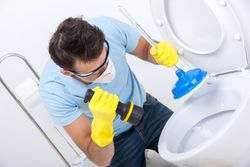
Partially because they are subterranean and partially because they involve waste, sewer lines are rarely at the forefront of any resident’s mind. But having some knowledge about these structures will help you limit irritating plumbing issues and save costs on potential repairs. Here are answers to commonly asked questions about everything from clogs to sewer line inspections.
Answers to Common Questions About Sewer Lines
What is the most common sewer line problem?
The two most typical issues are clogs and interfering roots. In the case of a clog, it’s usually because residents are using their toilets as secondary trash receptacles. Items such as floss, condoms, tampons, and baby wipes create a blockage that makes it nearly impossible for waste or wastewater to travel past. Generally, a plumber’s snake can dislodge a moderate clog. Additionally, there are many times when the root system of a nearby tree will dislodge part of the line. The tree may need to be removed to restore the system.
How can you tell there’s an issue?
 The most obvious signs that there’s an issue with your sewer line is if your drains start backing up and your toilets become difficult to flush. Usually, that means that the line has a blockage, the pipes have started corroding, or the whole line has become detached. In some cases, the only way to tell is with the help of a camera, which is usually part of a sewer line inspection.
The most obvious signs that there’s an issue with your sewer line is if your drains start backing up and your toilets become difficult to flush. Usually, that means that the line has a blockage, the pipes have started corroding, or the whole line has become detached. In some cases, the only way to tell is with the help of a camera, which is usually part of a sewer line inspection.
Who’s responsible for repair work?
In most areas, the homeowner is responsible for any repairs needed on their sewer lines. It’s worth checking with your municipality, though, because some towns will help you with the work. In either case, it’s important to notify the local government since you are connected to the public system. Failure to do so can result in a fine.
What are best practices for avoiding problems?
As a first step, remind all members of your households to flush only toilet paper. Place a garbage can in the bathroom to encourage everyone to throw away non-flushable items. Just as importantly, schedule a sewer line inspection at least once a year. That way, a technician can quickly anticipate problems and make the small repairs or adjustments needed to avoid failure later.
If it’s been a while since your last sewer line inspection, get in touch with the respected sewer crew at Bigfoot Pumping & Thawing in North Pole, AK. Serving the community for over 25 years, the locally owned family business will keep your sewer lines in check, pump your septic tank as needed, and repair your toilet in case of breakage. To request their 24/7 emergency service or to schedule a camera inspection, call (907) 488-9855, and learn more about their sewer services on their website.
About the Business
Have a question? Ask the experts!
Send your question

